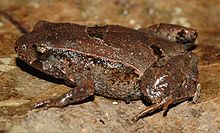Assa (genus)
| Pouched frog | |
|---|---|
 |
|
| Scientific classification | |
| Kingdom: | Animalia |
| Phylum: | Chordata |
| Class: | Amphibia |
| Order: | Anura |
| Family: | Myobatrachidae |
| Genus: |
Assa Tyler, 1972 |
| Species: | A. darlingtoni |
| Binomial name | |
|
Assa darlingtoni Loveridge, (1933) |
|
 |
|
| Range of the pouched frog | |
The pouched frog (Assa darlingtoni) is a small, terrestrial frog found in rainforests in mountain areas of south-eastern Queensland and northern New South Wales, Australia. It is the sole species within the genus Assa, and is part of the family Myobatrachidae.
It is a small frog about 2.5 cm long, red-brown in colour, with some individuals having reverse V shaped patches and/or with light brown dots randomly on their backs. Most specimens have a darker brown stripe that runs from the nostril through the eye down the side of the body. A skin fold is present on either side of the frog running from its eye to its hip. Its hands and feet are completely free of webbing and discs, but the tips of the fingers and toes are swollen. The eye is gold with brown flecks and when the pupil is constricted it is horizontal. There is a 'pocket' on its hip where the frog's tadpoles travel to after hatching.
This frog hides under logs, rocks, and leaf litter in rainforests and adjacent wet sclerophyll forests. It may call through the day but calling is most intense during dawn and dusk. Its call is a very quiet eh-eh-eh-eh-eh-eh, usually six to ten notes. This frog crawls rather than hops. Females are believed to first start breeding between 2 and 3 years and a single female may produce 1–50 eggs a year. Eggs are laid on the land (under decomposing logs, rock or leaf litter) as the tadpoles do not need water for metamorphosis. Breeding takes place during spring and summer. Both male and female frogs guard the nest of eggs and the male carries the tadpoles in the pouch once they have hatched. The tadpoles will reside in the pouch until they have morphed.
This species formerly experienced declines, however it has recovered [needs citation].
Although this frog is the only species in its genus, it may be confused with Philoria loveridgei (Loveridge's frog). Philoria loveridgei has angular skin folds on its dorsal surface and thicker arms than Assa darlingtoni.
...
Wikipedia

